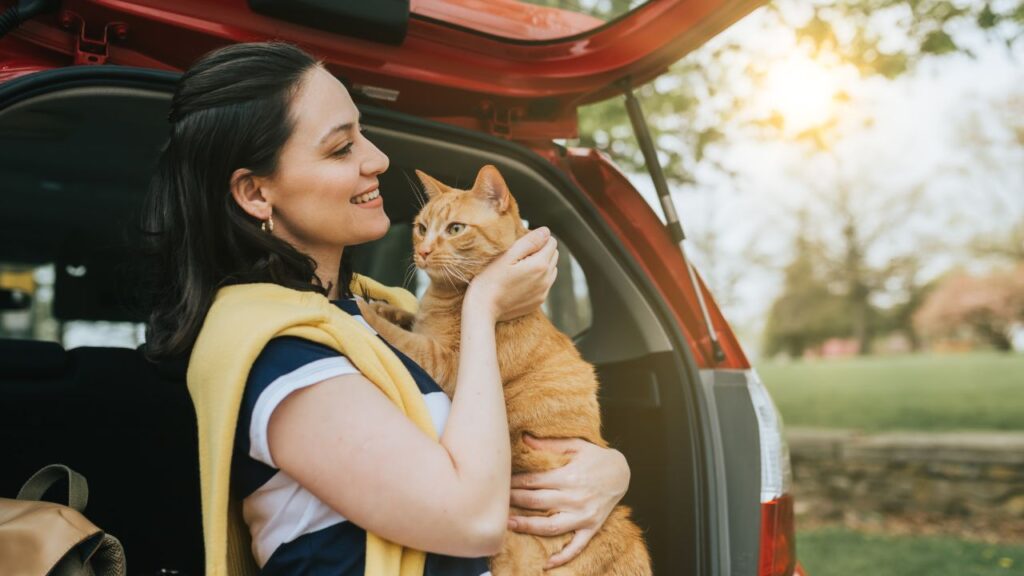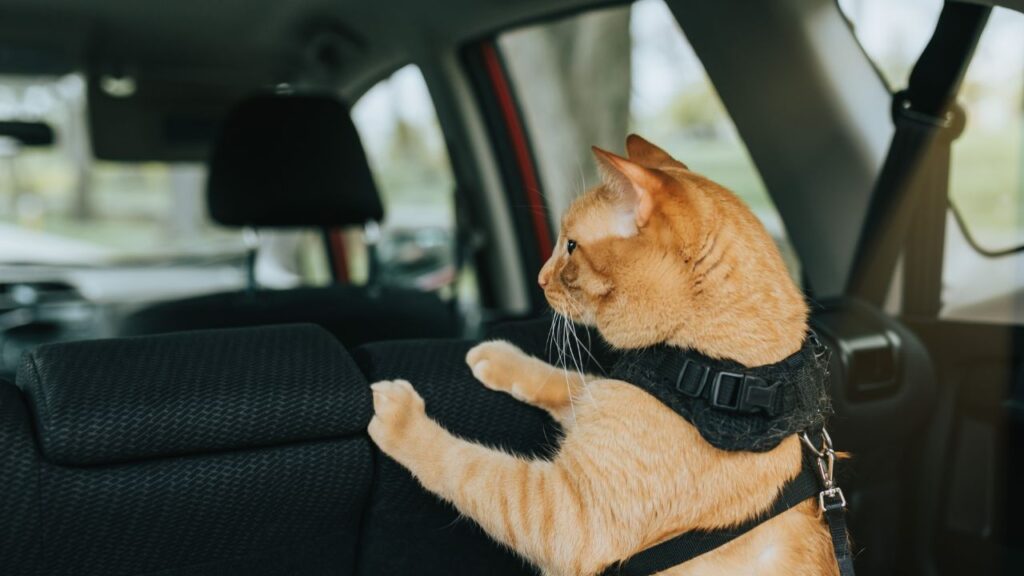If you’re planning a long road trip with your furry feline companion, you’re probably wondering: how to travel with cats long distance in a car? Trust me, you’re not alone. Traveling with cats long distances in a car can seem daunting, especially if you’ve never done it before. But here’s the good news—it’s totally doable! With a little preparation, some patience, and a few tricks up your sleeve, you and your cat can have a smooth, stress-free journey.
This guide: how to travel with cats long distance in a car? covers everything you need to know, from pre-trip preparations to keeping your kitty comfortable on the road. So grab a coffee, sit back, and let’s dive into the world of car travel with cats.
Contents
- 1 Why Traveling with Cats is Different
- 2 Pre-Trip Preparations: Setting Yourself Up for Success
- 3 On the Road: Keeping Your Cat Calm and Comfortable
- 4 Common Challenges and How to Handle Them
- 5 Arriving at Your Destination: Helping Your Cat Settle In
- 6 Quick Answers to Common Questions
- 7 Final Thoughts: You’ve Got This!
Why Traveling with Cats is Different
Traveling with Cats? Don’t worry, from here you will be learn how to travel with cats long distance in a car. Let’s face it: cats are creatures of habit. They thrive on routine, familiar surroundings, and a sense of control over their environment. So when you suddenly pack them into a car for hours (or days), it can be… well, overwhelming.
Unlike dogs, who often view car rides as thrilling adventures, cats may associate travel with trips to the vet—not exactly their idea of fun. But don’t worry! With the right approach, you can turn a nerve-wracking experience into a manageable (and maybe even enjoyable) one.
Pre-Trip Preparations: Setting Yourself Up for Success
1. Choose the Right Carrier
Let’s discuss about how to travel with cats long distance in a car? First things first: a sturdy, comfortable carrier is a non-negotiable. Your cat needs a secure space where they can feel safe during the journey.
- Soft-Sided vs. Hard-Sided Carriers: Soft-sided carriers are lightweight and easier to store, but hard-sided ones offer better protection.
- Size Matters: The carrier should be big enough for your cat to stand up, turn around, and lie down comfortably.
Pro Tip: Introduce the carrier well before the trip. Leave it out at home with a cozy blanket and maybe a few treats inside. Let your cat explore it at their own pace.

2. Get Your Cat Used to the Car
If your cat isn’t familiar with car rides, start with short trips around the block. Gradually increase the duration to help them acclimate.
- Make It Positive: Bring along their favorite treats or toys. End each practice ride with a reward—like playtime or a snack—to create positive associations.
3. Schedule a Vet Visit
Before hitting the road, it’s a good idea to check in with your vet.
- Vaccinations: Ensure your cat is up to date on all vaccinations.
- Medications: If your cat gets anxious or carsick, ask your vet about calming aids or anti-nausea medication.
- Microchip: Make sure your cat’s microchip information is current, just in case they get lost.
4. Pack a Cat Travel Kit
Here’s a quick checklist of essentials:
- Carrier (obviously!)
- Litter box and litter (travel-sized options work great)
- Food and water bowls
- Your cat’s regular food
- Treats
- Toys or a blanket that smells like home
- Waste bags for cleaning up
- A harness and leash (yes, even if your cat is strictly an indoor kitty)
On the Road: Keeping Your Cat Calm and Comfortable
1. Secure the Carrier
Safety first! Place the carrier in a secure spot in the car, like the backseat, and use a seatbelt to keep it stable. Avoid putting the carrier in the front seat—airbags can be dangerous for pets in the event of an accident.

2. Create a Comfortable Environment
Think about what makes your cat feel at ease.
- Temperature: Keep the car at a comfortable temperature—not too hot or cold.
- Noise: Cats have sensitive hearing, so keep the radio at a low volume. You might even try playing calming music designed for pets.
Fun Fact: There are playlists and albums specifically created to soothe cats—just search for “cat calming music” on your favorite streaming platform!
3. Stick to Their Routine
Try to maintain your cat’s usual feeding and bathroom schedule as much as possible.
- Food and Water Breaks: Offer food and water during stops, but don’t overfeed—they’re more likely to get carsick on a full stomach.
- Litter Box Breaks: Portable litter boxes are a lifesaver. During longer stops, set up the litter box in a quiet, enclosed space (like the car with the doors closed).
4. Watch for Signs of Stress
Cats can’t tell you they’re stressed in words, but their body language speaks volumes.
Look out for:
- Excessive meowing or growling
- Panting (a sign of anxiety)
- Hiding or refusing to leave the carrier
If your cat seems distressed, take a break. Park the car, offer some water, and give them a moment to calm down.
Common Challenges and How to Handle Them
1. What If My Cat Gets Carsick?
Motion sickness is a real thing for cats. Signs include drooling, vomiting, and lethargy.
- Solution: Keep the carrier facing forward to reduce nausea. Avoid feeding your cat right before the trip, and consider asking your vet about anti-nausea medications.
2. What If My Cat Won’t Stop Meowing?
Some cats are vocal travelers.
- Solution: Speak to them in a soothing tone. You can also try covering the carrier with a light blanket to create a sense of security.
3. What If My Cat Escapes?
It happens—sometimes cats are sneaky little escape artists.
- Solution: Always use a harness and leash when letting your cat out of the carrier. Make sure the car doors and windows are closed before opening the carrier.
Arriving at Your Destination: Helping Your Cat Settle In
After knowing how to travel with cats long distance in a car, once you’ve reached your destination, your cat might need some time to adjust.
- Set Up a Safe Space: Choose a quiet room where they can relax and explore at their own pace. Include familiar items like their blanket, litter box, and food.
- Give Them Time: Don’t force them to explore right away. Cats need to feel secure before they venture out.
Quick Answers to Common Questions
Q: How long can a cat stay in a carrier during a car ride?
A: Cats can usually stay in a carrier for 4–6 hours at a time. Make sure to stop for breaks so they can stretch, eat, and use the litter box.
Q: Should I sedate my cat for a long trip?
A: Sedation should only be considered as a last resort and under the guidance of a vet. There are also natural calming solutions, like pheromone sprays or supplements, that might help.
Q: Can I let my cat roam freely in the car?
A: It’s not safe to let your cat roam freely. Always keep them in a carrier to prevent distractions and ensure their safety.
Final Thoughts: You’ve Got This!
Traveling with cats long distance in a car might sound like a challenge, but with a little preparation and a lot of love, you can make it work. Remember, your cat looks to you for reassurance—so stay calm, be patient, and don’t forget to enjoy the journey.
So, are you ready to hit the road with your feline friend by knowing how to travel with cats long distance in a car? Trust me, the memories you’ll create will be worth every effort. Safe travels!


